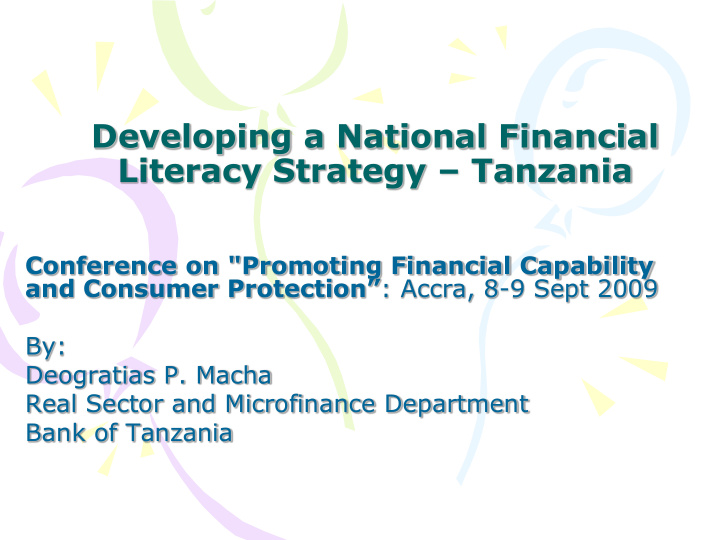



Developing a National Financial Literacy Strategy – Tanzania Conference on "Promoting Financial Capability and Consumer Protection” : Accra, 8-9 Sept 2009 By: Deogratias P. Macha Real Sector and Microfinance Department Bank of Tanzania
The Country context Key Socio – economic features : URT – Union of Tanganyika and Zanzibar Total Area 945,000 sq. km (Mainland 881,000 sq. km; Zbr 2000 sq. km; rest water surface); Population – est. 39mil (2008); rural/urban -72%/28%; Population density = 38 persons per sq. km --- Tz Mainland and 400 per sq. km--- Zanzibar (2002 Census); More women than men both in rural and urban areas Adult illiteracy rate (15yrs and older) = 28% (Human Dept Report 2008) GDP Growth rate = 7.4% (2008) GDP per capita ≈ USD 480 (2008) Savings/GDP ≈ 12% Inflation rate = 10.9% (July 2009); Interest spread ≈13%
Financial Sector: - 1 st Generation Financial Sector Reforms focused on liberalizing financial sector - various Acts and Policies formulated; Results: Increased competition and efficiency in the banking sector (3 banks in 1991 to 26 in 2006 (38 Banks in August 2009) Review/development of the legal and regulatory framework, and polices for the financial sector; Persisting challenges: Small/shallow financial sector system; Still inadequate legal and judicial environment and conducive policies for the sector; Low access of financial services to majority of Tanzanians; Low financial education and literacy;
Overall financial penetration 2% 5% 35% 54% Formal (Banks and Insurance): Semi - formal (SACCOS and Financial NGOs) Informal Excluded
Financial Penetration: Rural vs Urban 2% 18% 32% 11% 34% Urban 1% 2% 5% 36% 24% 33% Rural Formal (Banks and Insurance): Formal - Others Semi - formal - SACCOS and Financial NGOs Informal Excluded - Non-monetary Excluded - Totally unserved
• Fin. Penetration (banked) --lowest in Tanzania compared to: • Nambia =51%, • SA =50%, • Botswana =41%, • Kenya =19%, • Uganda =18%, • Zambia =15% • Major reasons for low access: – Subsistence economy; – Poor infrastructure: the biggest single business constraint; – High illiteracy rates: Education > 15 yrs (28%) and Financial (80% rural);
Access Strand by Education profile FI - Formally Included SI - Semi Formal II - Informally Included E - Excluded University Post Secondary Training Secondary Post Primary Training Primary Pre-primary No Formal Schooling 0% 10% 20% 30% 40% 50% 60% 70% 80% 90% 100%
Barrier - never heard of Total adult population
Barrier - never heard of Total adult population
Barrier - never heard of
Barrier - never heard of
Financial education needs 79% Insuring/covering your assets How to manage your money effectively 80% 81% Understanding banks, M FIs or Saccos charges/fees 81% Insuring/covering your life How to open an account in a bank 82% Understand the services/products provided by financial service 82% providers 83% How much of a loan you can afford to apply for How to save more money 84% 84% How interest rates work/calculated
2 nd Generation Financial Sector Reforms • Aim at: – Improving access to financial services – Developing vibrant primary and secondary markets; – Ensuring efficient and sound banking system; – Promoting an efficient and competitive pension sector by developing an efficient legal and regulatory framework – Promoting an efficient, sound and competitive insurance industry with different products, wider outreach and market based investment policies; – Establishment of viable and sustainable microfinance industry, with wider outreach; – Ensuring labour laws and labour relations policies that support financial sector devpt are in place; – Strengthening mechanism for adjudication of land disputes by registering land and search services – Addressing the gap in the provision of long-term credit in productive sectors; • 10 components of the reforms: Legal and judicial; Monetary policy; Banking sector; Financial Markets; Pension Sector; Insurance Sector; Long term finance; Micro and Rural Finance; Land; and Employment.
Rationale For Developing Financial Literacy Strategy • Devpt of Fin. Lit Strategy built on FinScope 2006 findings • No inclusive approach to financial education in the country; • Efforts fragmented and short lived, mainly aimed at marketing products; • Strategy to cut across all components of the 2 nd Gen. Fin. Sector Reforms: • Positive outcome of reforms depends on Fin. Lit Str. and associated programmes – building sophisticated demand base of financial services;
National Goals: • Coordination framework at national level to guide Fin. Ed. Initiatives and programmes; • Programmes customized to different sectors and target groups; • Increased fin. education and fin. literacy; • Transparency and improved financial services and products • Targets and monitoring indicators – process
Framework for Developing the Strategy • Coordinated by the Bank of Tanzania under Financial Sector Support Project (FSP) • Overseen by Micro and Rural Finance Technical Committee (11 members from key ministries (Ministries of Agriculture, Finance and Education), SACCOS apex body, 2 commercial banks, FSDT and BOT); Project Coordination Committee and IIC (18 members); – Consultancy started in June 2009, to be finalized in early 2010
“ Money is one form of power, but what is more powerful is financial education. Money comes and goes, but if you have the education about how money works, you gain power over it and can begin building wealth ”. ( Kiyosaki and Sharon, 1995)
THANKS
Recommend
More recommend